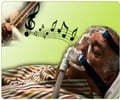Struggling with sleeplessness? A pilot clinical study uses musical notes to balance brain activity that can help you sleep well.

Researchers at Wake Forest Baptist Medical Center have conducted a pilot clinical study to determine whether a non-invasive approach, that uses musical tones to balance brain activity, can 'reset' the brain and effectively reduce insomnia.
The study, was published online in October, advance of print, in the journal Brain and Behavior. It was funded by a $26,696 grant from Brain State Technologies, LLC, Scottsdale, Ariz., the company that owns the technology used in the study.
Charles H. Tegeler, M.D., professor of neurology at Wake Forest Baptist and principal investigator of the study explained how the technology works. "The human brain is made up of the left and right hemispheres that work together as parallel processors. When a person undergoes trauma or a major stressor, their autonomic survival responses kick in and the brain can become unbalanced. If those imbalances persist, symptoms such as insomnia can result. Our study looked at a new technology that is intended to facilitate greater balance and harmony in brain frequencies, which may result in improved symptoms."
The new technology is called HIRREM, high-resolution, relational, resonance-based, electroencephalic mirroring or, as it's commercially known, Brainwave Optimization™. The non-invasive procedure uses a system that is designed to reflect the brain's frequencies back to itself using musical tones. Resonance between the musical tones and the electrical energy in a person's brain can bring balance to the two hemispheres of the brain.
Study results were based on a change in the Insomnia Severity Index (ISI) which measures the severity of sleep disruption using a zero-to-28 point scale; the median ISI for study participants was between 18.7 and 18.9, which is considered moderate-to-severe insomnia.
Advertisement
This unblinded, wait-list control, crossover study enrolled 20 participants (14 women and 6 men). Ten people were randomized to receive HIRREM sessions, plus usual care; the remaining 10 were assigned to the wait-list control group. An initial assessment determined the symmetry, or balance, in amplitude and frequencies between the brain hemispheres and data collection included a subject's ISI and other measures including blood pressure and neurocognitive function tests.
Advertisement
The limitations of the study include the small number of study participants and the absence of a sham-placebo control group which prevented blinding. This means it is possible that the changes observed with HIRREM, could be due to a placebo effect. In addition, because HIRREM therapy involves social interaction and relaxation, there may be other non-specific mechanisms for improvement, in addition to the tonal mirroring. Although the researchers believe that the degree of improvement and length of time it persisted (for four weeks after the last session) suggests real change through HIRREM, Tegeler is planning a larger clinical trial using a sham placebo, to confirm the HIRREM effect and further explore the technology.
Source-Eurekalert










